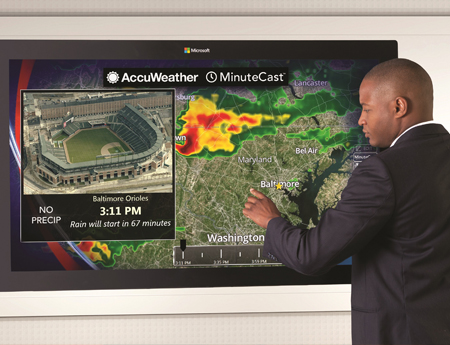It’s Blue Skies for Weather System Upgrades

While forecasters are predicting a quieter hurricane season this year, a tempest of tech changes is blowing through the major providers of broadcast TV weather systems, powering a number of major upgrades.
These advances, which include better data from greatly improved radar systems, enhanced graphics, hyper-local forecasting and new mobile technologies, are important because local weather remains the most important reason why people tune into local newscasts, and a major source of revenue for station groups.
One notable development was the completion of the deployments of dual polarization radar systems in 2013 by the National Weather Service, which is now providing a foundation for more sophisticated data and forecasting.
Ardell Hill, president of Broadcast Operations at Baron Services, which installed the new radar systems, notes that they allow meteorologists to see hail during thunderstorms, and can even show the debris kicked up by a tornado, so stations can tell where a tornado has touched down much faster than ever before. “It is really a quantum leap forward,” that has allowed them to develop new products like their Hurricane Index, Hill says.
Big Data Storms
Improved data from a variety of sources and the ongoing trend toward much improved processing power is also producing much higher quality, more realistic graphics at systems being sold by Baron Services and other vendors.
Bill Dow, senior VP and general manager of WSI’s media division, which offers the WSI and Weather Central systems, notes that they’ve made a number of improvements to both products since WSI acquired Weather Central in 2012.
Broadcasting & Cable Newsletter
The smarter way to stay on top of broadcasting and cable industry. Sign up below
Their newly launched Max Sky product, for example, lets stations show hyper- realistic scenes of how the weather will change, with over 200 different types of clouds, astronomically correct positioning of the stars and the moon, lighting transitions from day to night and accurate cityscapes. In addition, Max Sky has been integrated with their traffic system to show the impact of weather on commuters. “Max Sky provides the kind of visualization of the weather and its impact that hasn’t been seen on TV,” Dow says.
Improved data and new mobile technologies also open up new opportunities for much more detailed hyper-local forecasting and the use of mobile technologies to improve TV weather systems.
Weather has always been one of the most popular apps on tablets and smartphones, and mobile services are a top priority at all the major providers. AccuWeather, which has apps on some 1.3 billion devices around the world, is now using services developed for mobile to improve its TV weather systems, explains Ryan Ayers, VP/display systems for AccuWeather.
As part of its app development, for example, AccuWeather developed a MinuteCast app that shows when rain and other weather will start or stop at the user’s specific location during the coming two hours. Subsequently, it has added this feature and other interactive capabilities to its StoryTeller interactive touchscreen system. “You can click on a map and get a MinuteCast to see when precipitation will start and stop on a specific street corner,” Ryan says. “Right now, we are the only company that has minuteby- minute hyper-local forecasts.”
THE FORECAST FOR SOCIAL MEDIA
With stations looking to better engage viewers and draw on user-generated content to improve newscasts, vendors have been making significant improvements to their social media tools.
AccuWeather has developed tools so that stations can show social media posts from specific locations, such as a stadium, as part of StoryTeller, explains Ryan Ayers, VP of display systems at the company, which has announced tools for taking feeds from drones.
Baron, WSI and Weather Central have also been adding social media tools. WSI’s Max Social module streamlines the ability to post content to Twitter and other social media sites and simplifies the process of using social media content on the air, explains Bill Dow, senior VP and general manager of WSI’s Media Division. “As new photos and videos come through from social media, one person can vet it and put it in a container to go on-air,” he says.










